
Matsutake, Tricholoma matsutake, is a species of choice edible mycorrhizal mushroom that grows in East Asia, northern Europe, and North America. It is prized in Japanese cuisine for its distinct spicy-aromatic odor.

Tricholoma is a genus of fungus that contains many fairly fleshy white-spored gilled mushrooms which are found worldwide generally growing in woodlands. These are ectomycorrhizal fungi, existing in a symbiotic relationship with various species of coniferous or broad-leaved trees. The generic name derives from Ancient Greek: τριχο-, romanized: tricho-, lit. 'hair' and Ancient Greek: λῶμα, romanized: loma, lit. 'fringe, border' although only a few species have shaggy caps which fit this description.
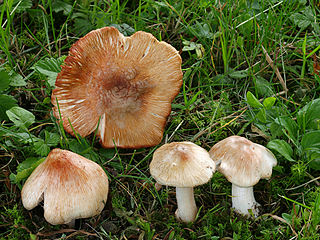
Inocybe erubescens, also known as I. patouillardii, commonly known as the deadly fibrecap, brick-red tear mushroom or red-staining Inocybe, is a poisonous basidiomycete fungus, one of many in the genus Inocybe and one of the few known to have caused death. It is found growing in small groups on leaf litters in association with beech. All mushroom guidebooks as well as mushroom hunters advise that the entire Inocybaceae should be avoided for consumption. The fruit bodies appear in spring and summer; the bell-shaped caps are generally pale pinkish in colour with red stains, with a reddish-pink stipe and gills.
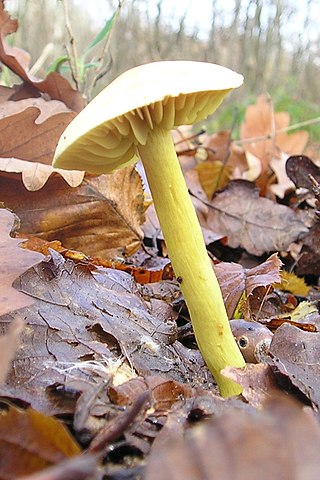
Tricholoma sulphureum, also known as the stinker, sulphur knight or gas agaric, is an inedible or mildly poisonous mushroom found in woodlands in Europe. It has a distinctive bright yellow colour and an unusual smell likened to coal gas. It occurs in deciduous woodlands in Europe from spring to autumn.

Peziza praetervisa, commonly known as the purple fairy cup or the fireplace cup, is a species of fungus in the genus Peziza, family Pezizaceae. Recognized by its flattened, purple, cup-like fruitbodies, this widespread fungus typically grows scattered or in clusters on burnt ground.

Tricholoma terreum, commonly known as the grey knight or dirty tricholoma, is a grey-capped mushroom of the large genus Tricholoma. It is found in coniferous woodlands in Europe, and has also been encountered under introduced pine trees in Australia and New Zealand. It is regarded as edible. A 2014 article speculated that it may be poisonous, but Sitta et al. in 2016 published in the same journal a counter article demonstrating the unfounded nature of such speculation.

Phylloporus rhodoxanthus, commonly known as the gilled bolete, is a species of fungus in the family Boletaceae. As suggested by its common name, the distinctive feature of this species is its yellow gills—an unusual feature on a bolete mushroom.

Tricholoma saponaceum, also known as the soap-scented toadstool, soapy tricholoma, soapy knight or soap tricholoma is an inedible mushroom found in woodlands in Europe and North America.
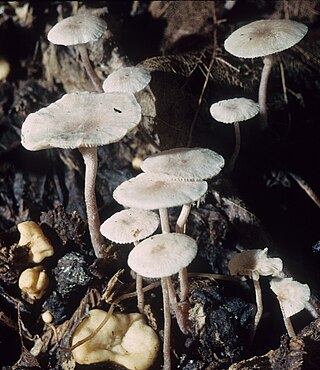
Collybia cookei is a species of fungus in the family Tricholomataceae, and one of three species in the genus Collybia. It is known from Europe, Asia, and North America. The fungus produces fruit bodies that usually grow on the decomposing remains of other mushrooms, like Meripilus giganteus, Inonotus hispidus, or species of Russula; occasionally fruit bodies are found on rich humus or well-decayed wood. The fungus produces small white mushrooms with caps up to 9 mm (0.35 in) in diameter, supported by thin stems that originate from a yellowish-brown sclerotium. The mushroom is difficult to distinguish from the other two species of Collybia unless an effort is made to examine the sclerotia, which is usually buried in the substrate. The edibility of the mushroom has not been determined.

Hygrophorus marzuolus, commonly known as the March mushroom, is a species of fungus in the family Hygrophoraceae. It is known from Asia, Europe, and North America, where it grows on the ground in mixed forests at high elevations.
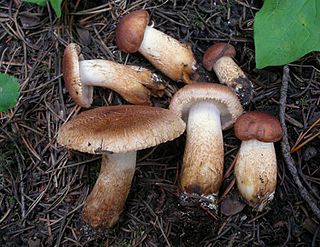
Tricholoma vaccinum, commonly known as the russet scaly tricholoma, the scaly knight, or the fuzztop, is a fungus of the agaric genus Tricholoma. It produces medium-sized fruit bodies (mushrooms) that have a distinctive hairy reddish-brown cap with a shaggy margin when young. The cap, which can reach a diameter of up to 6.5 cm (2.6 in) wide, breaks up into flattened scales in maturity. It has cream-buff to pinkish gills with brown spots. Its fibrous, hollow stipe is white above and reddish brown below, and measures 4 to 7.5 cm long. Although young fruit bodies have a partial veil, it does not leave a ring on the stipe.

Tricholoma ustale, commonly known as the burnt knight, is a species of mushroom in the large genus Tricholoma. It is found in Asia, Europe, and North America, though those from North America may represent one or more different species.

Tricholoma pullum is a mushroom of the agaric genus Tricholoma. Described as new to science in 1989, it is found in eastern North America.
Tricholoma acre is a mushroom of the agaric genus Tricholoma. The fruit bodies have light gray caps and stems, light grey gills, and an acrid taste.

Tricholoma vernaticum is an agaric fungus of the genus Tricholoma native to the Pacific Northwest region of the United States. The fungus was originally described in 1976 as a species of Armillaria when that genus was more inclusive; it received its current name twenty years later. The stout fruit bodies (mushrooms) have moist white to grayish caps, a membranous ring on the stipe, and an odor resembling cucumbers. Mycorrhizal with conifers, the fungus fruits in the spring or early summer, with its mushrooms appearing on the ground singly or in groups at high elevations, often at the edge of melting snowbanks. The edibility of the mushroom is unknown, but it has a strong unpleasant odor and a mealy taste.
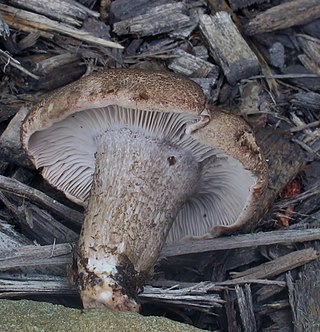
Pseudotricholoma umbrosum, commonly known as the amyloid tricholoma, is a species of fungus in the family Tricholomataceae, and the type species of the genus Pseudotricholoma. It was first described scientifically by mycologists Alexander H. Smith and Maurice B. Walters in 1943 as a species of Tricholoma. Rolf Singer transferred it to Porpoloma in 1962. The mushroom is found in North America, where it fruits singly or in small groups under conifer trees. Although it resembles a Tricholoma species, it is distinguished from that genus by its amyloid spores.

Hygrophorus russula, commonly known as the pinkmottle woodwax, false russula, or russula-like waxy cap, is a fungus native to North America and Europe.

Tricholoma roseoacerbum is an agaric fungus of the genus Tricholoma. The species was first described by Italian mycologist Alfredo Riva in 1979 as Tricholoma pseudoimbricatum var. roseobrunneum, but that name competed with an older homonym, William Murrill's 1913 Tricholoma roseobrunneum. Riva published the species with a new replacement name in 1984. T. roseoacerbum is found in Europe and northeastern North America. The specific epithet roseoacerbum alludes to the rosy colouration in its cap, and overall resemblance to T. acerbum. This species is probably conspecific with Tricholoma radotinense Pilát & Charvát (1959).

















